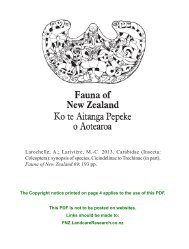Fauna of NZ 45 - Landcare Research
Fauna of NZ 45 - Landcare Research
Fauna of NZ 45 - Landcare Research
Create successful ePaper yourself
Turn your PDF publications into a flip-book with our unique Google optimized e-Paper software.
<strong>Fauna</strong> <strong>of</strong> New Zealand <strong>45</strong> 39<br />
Etymology. Strobilóbius is a Greek compound formed with<br />
the Greek word stróbilos, meaning vortex as well as pine<br />
cone, and bio for living; gender masculine.<br />
Strobilobius libocedri spec. nov.<br />
Fig. 14, 130, 137–148; Map 14<br />
May, 1993: 50, fig. 364–372 (as Neocyba species B, larva)<br />
Head and rostrum black, shiny, prothorax, sterna, antennae<br />
and legs usually dark brown, dull, swollen part <strong>of</strong><br />
femora reddish, elytra and abdomen yellowish red, moderately<br />
shiny, elytral suture darker. Vestiture very fine, inconspicuous<br />
on elytra, fine, appressed on pronotum, short<br />
and more conspicuous on underside and legs (Fig. 14).<br />
Anterior half or third <strong>of</strong> head capsule punctate. Rostrum<br />
in male 1.9x longer than prothorax, in female 2.25x, finely,<br />
sparsely punctate in male, indistinctly punctate in female.<br />
Funicular antennites 1–4 longer than wide, 5–7 usually as<br />
long as wide, 1 distinctly longer than 2. Prothorax 1.10–<br />
1.15x wider than long, alutaceously dull, finely punctate.<br />
Elytra 1.4–1.5x longer than wide. Finely transversely<br />
coriaceous; interstriae with a row <strong>of</strong> shallow puncta. Sides<br />
<strong>of</strong> metasternum and ventrites finely punctate. Remainder<br />
<strong>of</strong> characters in generic description.<br />
Length 2.4–2.9 mm.<br />
Types. Holotype male, 2.4 x 1.65 mm, Pouakai Trig, 1400<br />
m, 1 Dec 1975, sweeping, A. K. Walker, <strong>NZ</strong>AC. Paratypes<br />
AM<strong>NZ</strong>, <strong>NZ</strong>AC, FR<strong>NZ</strong>, MO<strong>NZ</strong>.<br />
Material examined. Holotype and 19 paratypes. North<br />
Island. TO. Makotuku Flat, Ohakune Mt Road; Turoa,<br />
Mt Ruapehu. TK. Pouakai Trig, Pouakai Ra; Tatakangi<br />
Peak, Pouakai Ra. South Island. DN. Dunedin Botanical<br />
Gardens. 20 adult specimens — see Appendix 2 for details<br />
<strong>of</strong> specimens examined.<br />
Distribution. TO, TK / DN.<br />
Host plant. Libocedrus bidwillii (Cupressaceae), larva in<br />
female strobili, two preserved at Forest <strong>Research</strong> Institute,<br />
Rotorua by Len Newman, who had attended to the<br />
rearing and found parts <strong>of</strong> a eulophid parasitic wasp in<br />
dissected cones.<br />
Remarks. There are two species <strong>of</strong> Libocedrus in New<br />
Zealand, and this weevil was found only on L. bidwillii.<br />
Kuschel (1995. 20) remarked that Apioninae were highly<br />
host-specific, almost exclusively associated with dicotyledons,<br />
with the exception, among two others on conifers, <strong>of</strong><br />
‘a species <strong>of</strong> Neocyba on Libocedrus’.<br />
Neocyba Kissinger<br />
Fig. 15, 149–157<br />
Kissinger, 1968: 7, 17 (type-species Apion metrosideros<br />
Broun)<br />
Head subcylindrical, faintly constricted a short distance<br />
behind eyes, strigose only laterally behind eyes, not across<br />
dorsal surface <strong>of</strong> base; temples as long as an anteroposterior<br />
diameter <strong>of</strong> eye. Frons flat, a little narraower than<br />
rostrum. Eyes distinctly elongate, weakly protruding laterally,<br />
dorsoventrally a little wider than depth <strong>of</strong> rostrum,<br />
finely facetted. Rostrum nearly as long as prothorax, cylindrical,<br />
slightly curved; in lateral view almost continuous<br />
with frons; epistome slightly sloping, emarginate; scrobes<br />
sulcate, directed towards gular angle, invisible in dorsal<br />
view. Antennae short, just reaching fore coxae, slightly<br />
antemedian in male, inserting on the middle in female; scape<br />
weakly clavate, curved outward at apex; first two segments<br />
<strong>of</strong> funicle elongate; club elongate-oval, outline <strong>of</strong><br />
segments well defined, segment 1 not or hardly a third <strong>of</strong><br />
the length <strong>of</strong> club.<br />
Prothorax longer than wide, subcylindrical, truncate at<br />
base, gently constricted at apex, not rimmed at base; in<br />
pr<strong>of</strong>ile moderately proclinate, 1.7x longer dorsally than<br />
ventrally. Scutellum small, punctiform, ascending vertically<br />
to level <strong>of</strong> elytra, lacking impression.<br />
Elytra gently widening with a slight curve to middle,<br />
more strongly curved on apical half, with humeral callus,<br />
without a lateral bulge on top <strong>of</strong> declivity, base vertical,<br />
sinuous, sutural interstria seemingly curved, tapering to<br />
the sides as a raised margin at base, dorsum in pr<strong>of</strong>ile<br />
gently convex, nearly level with pronotum, more strongly<br />
curved on apical half, transverse convexity on dorsum<br />
moderate; ten striae, all deeply sulcate, much narrower<br />
than interstriae, indistinctly punctate; striae 7 and 8<br />
coalescent from base to well behind humeral callus;<br />
interstriae nearly flat; inferolateral flange abruptly<br />
discontinued beyond the locking groove, whence without<br />
an incurving line or carina towards stria 2. Vestiture <strong>of</strong><br />
elytra and pronotum locally variable, from sparse to nearly<br />
absent, from obvious to inconspicuous, from prostrate to<br />
raised; one sensory hair on the posterior one-quarter <strong>of</strong><br />
interstria 7, another on interstria 9 near junction with 10,<br />
but one or both wanting with some frequency. Hind wing<br />
largely as for Strobilobius, Fig. 130, but radial window<br />
very narrow, elliptical or lineal; the medial stripe interrupted<br />
at the middle, and only two anal veins present.<br />
Mesepimeral suture deeply sulcate; meso- and<br />
metasternal processes not meeting between coxae. Process<br />
<strong>of</strong> ventrite 1 subtruncate; suture 1 <strong>of</strong> abdomen indistinct,<br />
just traceable; ventrite 5 in male in concave arc, in female<br />
broadly rounded, rimmed only on sides. Tergites pigmented,<br />
undivided; membrane between tergites 7 and 8 with small,<br />
shallow pouch in male.
















